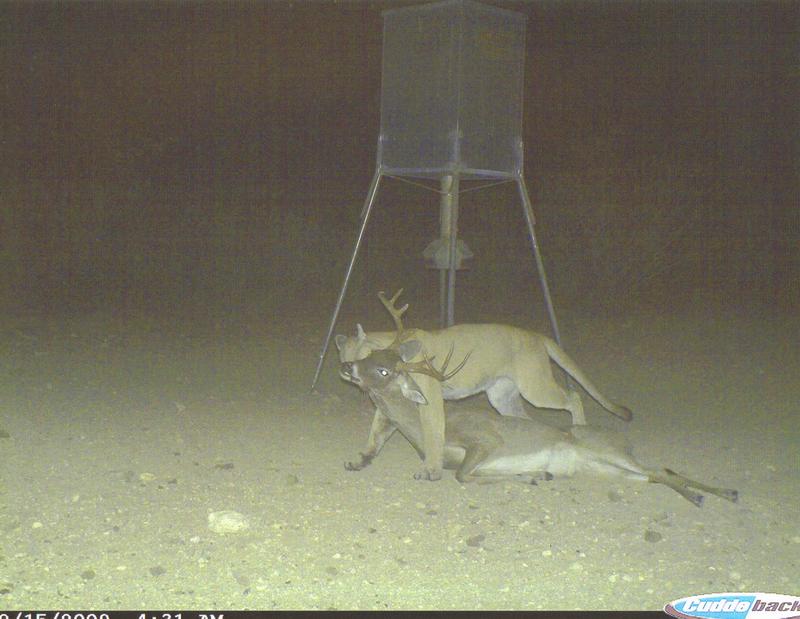Game cameras are great for hunters and deer management because they allow 24-7 surveillance of trails, feeders, food plots, and water sources. Not only can motion-triggered cameras be used to collect valuable survey data for herd management, but they can also capture some amazing wildlife photos, such as this awe-inspiring photo of a mountain lion dragging a whitetail buck directly in front of a protein feeder and right in the path of a game camera. Although it’s a great photo that demonstrates why an unlucky hunter may not be seeing any mature bucks, the mountain lion is simply doing what it does best.
Game cameras really do capture some great wildlife photos, but not all of the time. In today’s high-tech world, anyone with a little bit of computer knowledge can splice together parts of several photos and fabricate a seemingly amazing photo. I received the above mountain lion and deer photo in my inbox at least every other day for a couple weeks now, so hunters and non-hunters apparently find this photo fascinating and are passing it around. So why do predators get so much attention? I think part of it is the mystique surrounding them. They literally kill for a living. The other reason is because we as humans love to place blame. So although I believe this photo of a mountain lion carrying a buck is fake (May 16 update: the photo is real), predator management as part of your overall deer management program could be very real. Should you attempt to control predators on your property?
In areas where good deer habitat exists, predators do not pose a serious threat to white-tailed deer populations. The only real exceptions include islands of good habitat–say 500 acres or less–surrounded by vast expanses of poor habitat and then high-fenced ranches less than 1,000 acres in size. Good habitat not only makes for healthy does, which increases fawning rate, but also provides excellent fawning habitat that promotes increased fawn survival. These two factors are critical to the recruitment of deer into the population, but good habitat will not make a difference if it’s only 200 acres surrounded by thousands of acres of poor habitat.
This is because the patch size of the habitat is important. Patch size is a biological term that refers to amount of available habitat. The smaller the patch size, the smaller the block of habitat, the more susceptible the patch becomes to the influence of predators. In the example above, the patch size of good habitat was 200 acres because it was assumed that the area surrounding it was not good habitat, as in areas over-grazed by livestock, huge bermuda fields, plowed fields, or wide open prairie. As the patch size decreases, the influence of predators of the deer population increases. In short, if there are 200 acres of prime habitat surrounded by nothing good for deer, then all of the deer and predators sink into that patch.
Now assume the patch size is 80 acres. It makes for easy pickin’ by predators. At some point the patch becomes so small that it does not function as habitat. A smaller patch increases the probability of predators encountering deer, particulary highly susceptible fawns. The same can be said about high-fenced or game-fence ranches, regardless of the habitat quality surrounding them. The issue with high-fenced ranches is that predators, such as coyotes, knowingly or unknowingly use the tall fences surrounding the property as funnels to corner deer. In low-fenced areas, deer can simply run away or run outside of the patch to safety. In high-fenced properties, deer are more prone to run down fencelines and, in a panic, continue to dart into the netwire fence and corners they can not jump.
As the size of a high-fenced property decreases, the percentage of the property that is near a fence line or corner increases. This means that smaller high-fenced ranches are more susceptible to high levels of predation than large high-fenced ranches. In addition, any high-fenced ranch is more susceptible to predation than low-fenced ranches surrounding it in the absence of predator control. This is only because taller-than-normal netwire fences impeed the escape of deer and increase the efficiency of predators.
With that said, high-fenced ranches have a greater ability to control predators than most low-fenced properties. The most notorious deer predator is the coyote because they are both numerous and crafty. Coyotes can go straight through barbed-wire fences, jump and climb 5-foot netwire fences, but 8 and 10-foot fences are a different story. As a result, coyotes can only go under high netwire fences. Slides, or locations where coyotes cross under netwire fencing, are easy to find and this makes them highly susceptible to traps, particularly snares. Smaller high-fenced properties are more susceptible to the impacts of predators on deer, but they are also easier to monitor and control.
To sum up, smaller ranches can provide good habitat that can sustain a white-tailed deer population, but smaller properties also require more intensive predator control, especially when surrounded by poor habitat. In addition, predators are easier to control on high-fenced properties because of limited predator access, but deer within ranches surrouned by tall netwire fences are very susceptible to predation because of corning. Supplemental feeding and food plots can keep deer healthy and help them grow bigger antlers, but good habitat and predator control, when necessary, can ensure that you have a deer to manage in the future.

